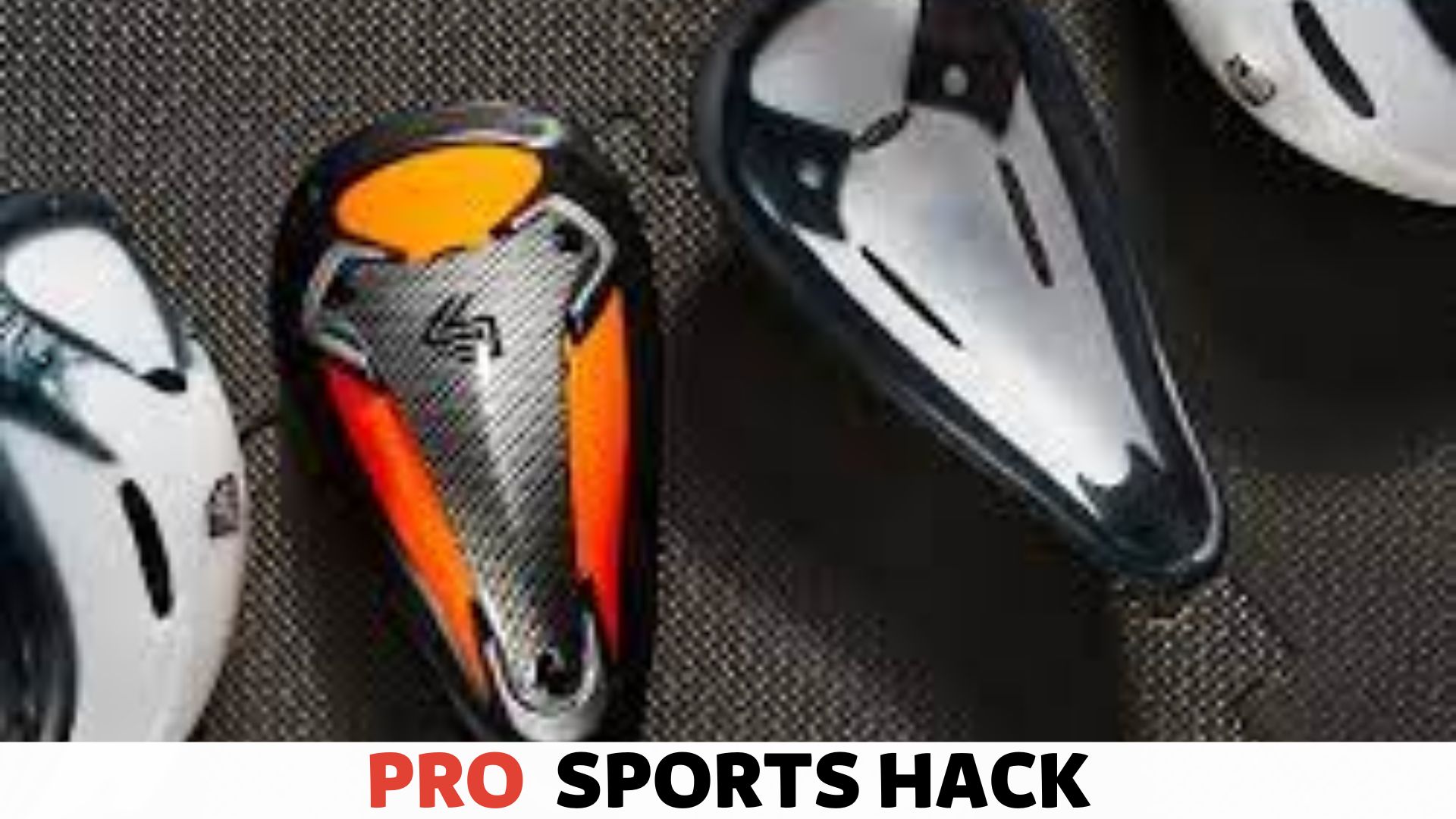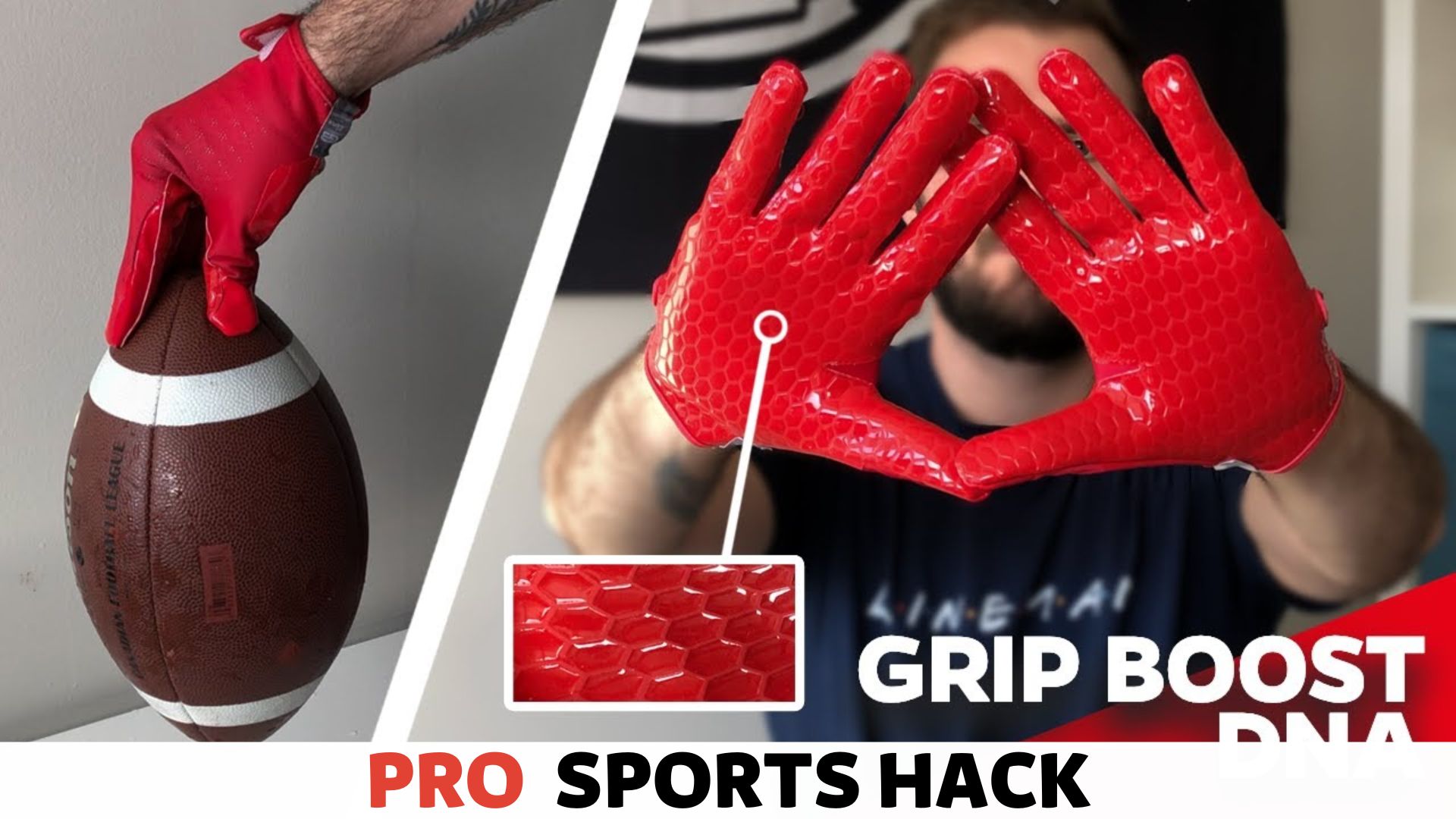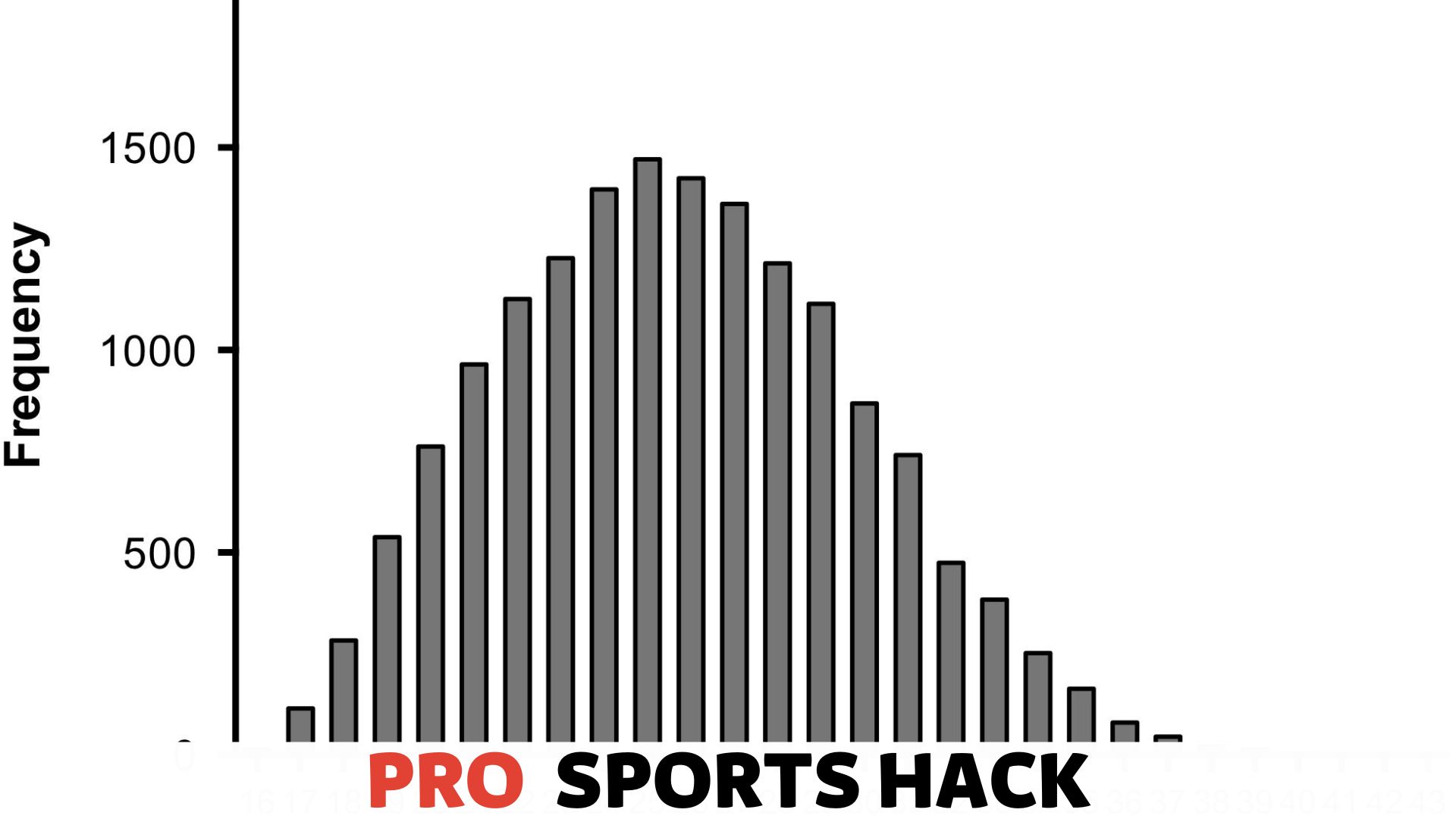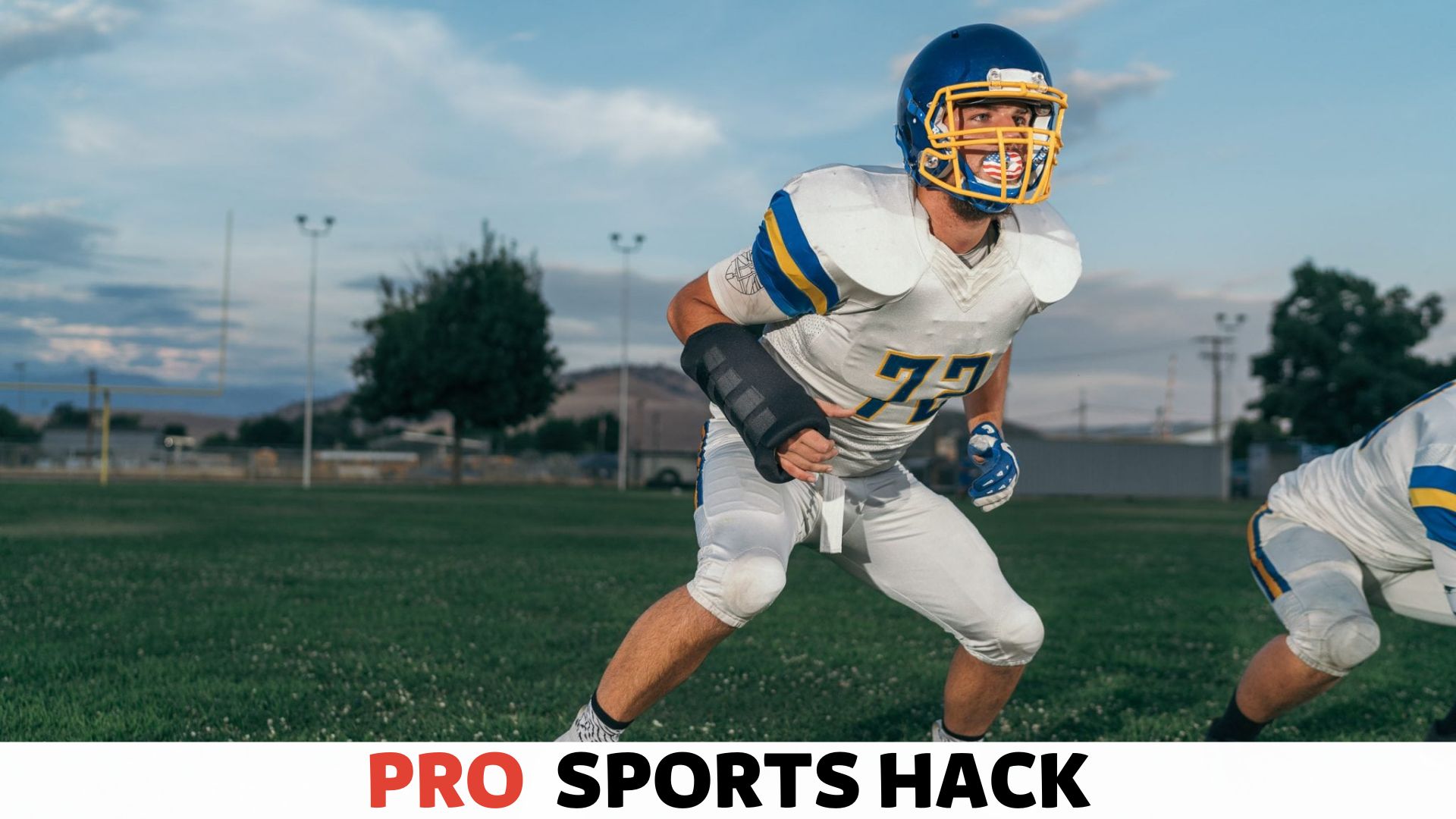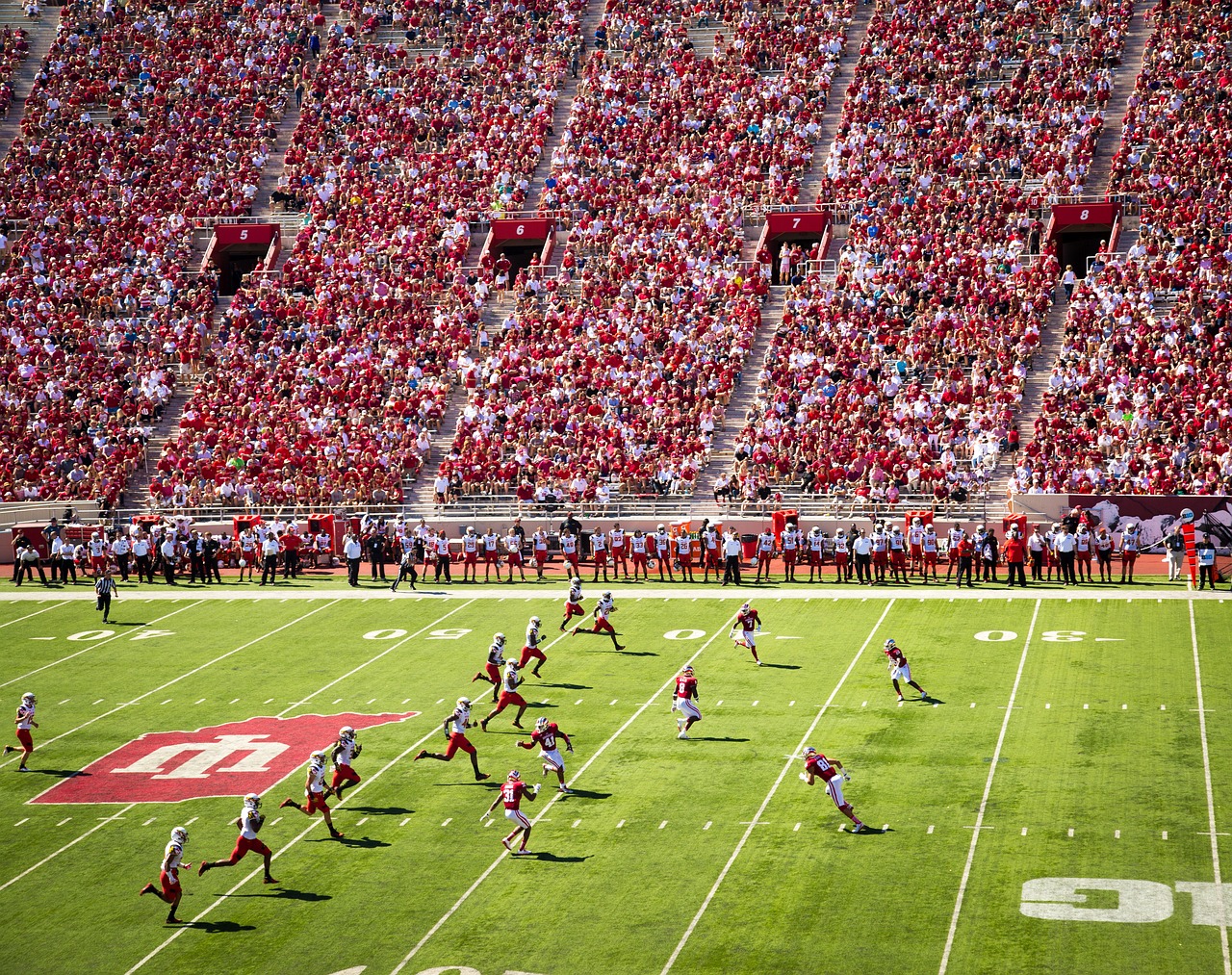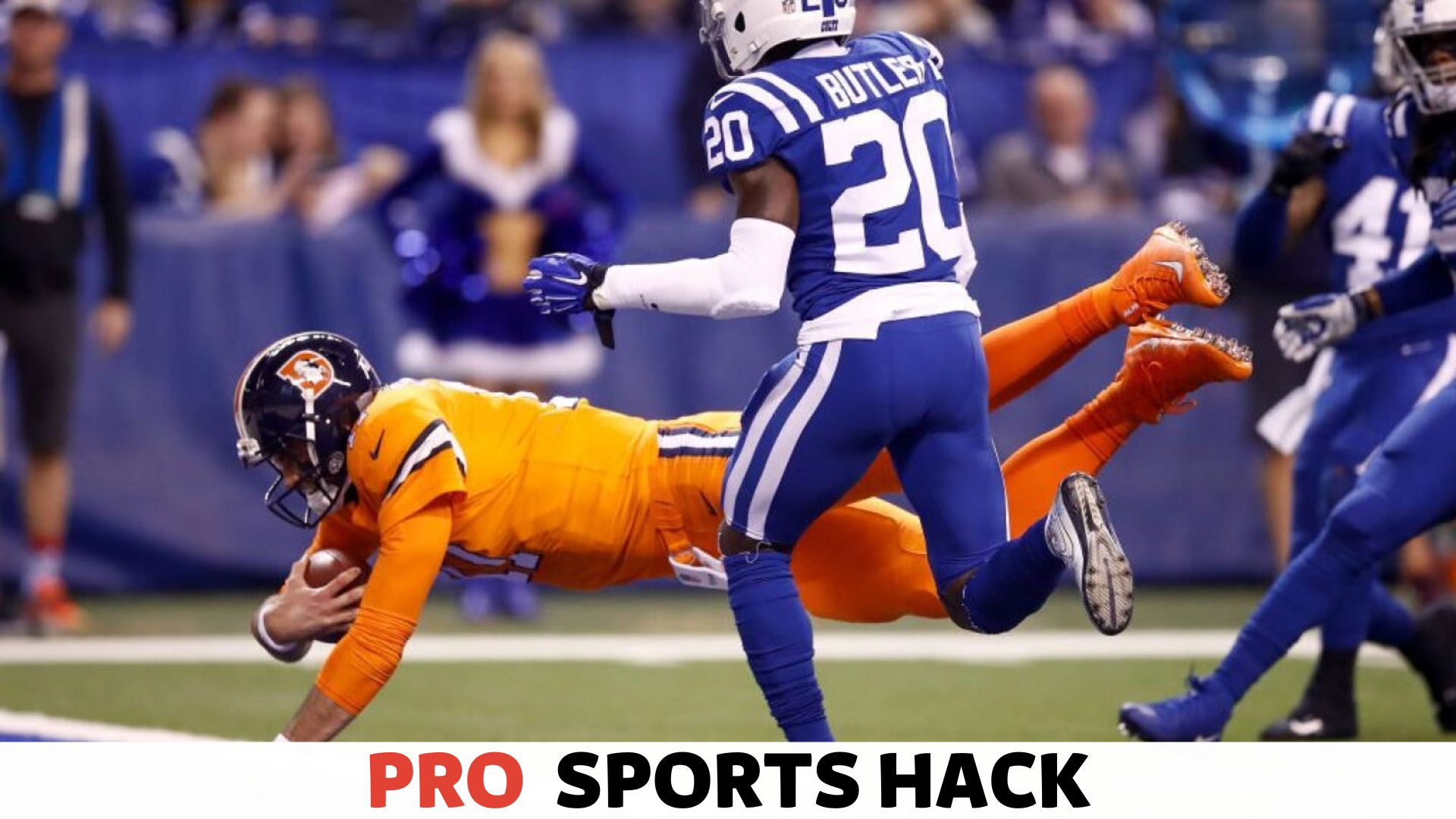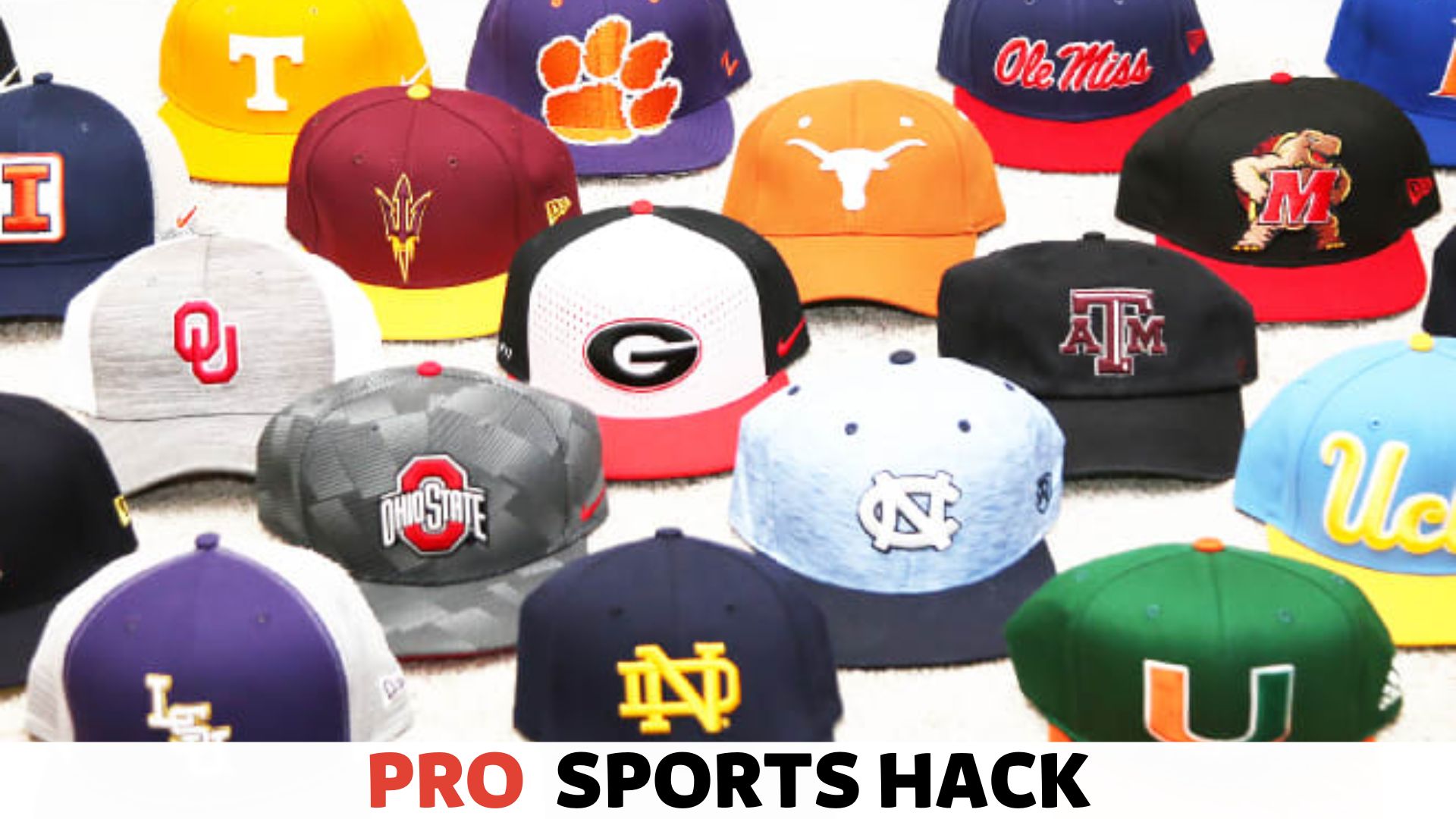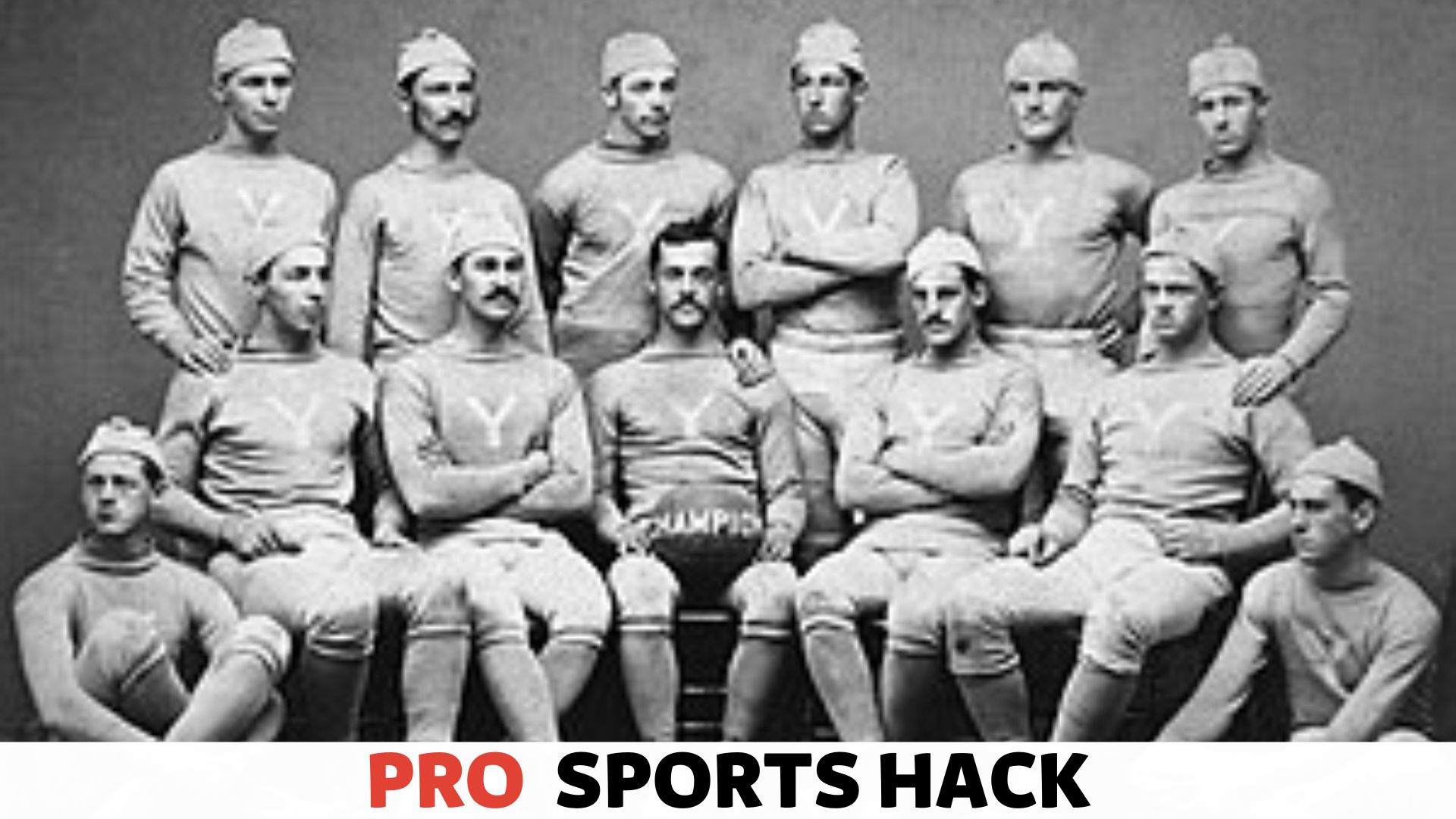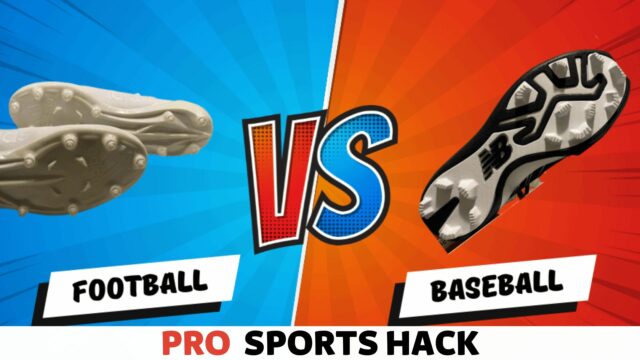
Football cleats and baseball cleats differ in design and purpose, with football cleats featuring studs for better traction on grass and baseball cleats having metal spikes to grip the dirt and grass surfaces of a baseball field. Football cleats feature studs that vary in length and pattern, while baseball cleats typically have three or four metal spikes on the heel and several smaller studs on the forefoot.
These variations make football cleats more suitable for the quick direction changes and lateral movements of football, while baseball cleats are designed for running and sliding on the diamond.
Choosing the right cleats depends on the specific sport and field conditions.
Football Cleats: A Closer Look
When choosing the right footwear for sports, it’s important to understand the specific requirements of each game.
In this article, we’ll look closer at football cleats and delve into the materials used, the design features, and the specialized traction that makes them essential for football gameplay.
Material Used for Football Cleats
Football players have to deal with intense physical contact, quick directional changes, and varying weather conditions.
To meet these demands, manufacturers use high-quality materials to ensure durability, stability, and performance for football cleats.
The upper part of football cleats is commonly made with synthetic leather or mesh material. Synthetic leather offers excellent durability and protection against external forces, while mesh provides a lightweight and breathable option, allowing players’ feet to ventilate properly.
Most football cleats feature rubber or thermoplastic polyurethane (TPU) for the outsole. Rubber outsoles provide superb traction on various fields, including grass and turf.
In contrast, TPU outsoles offer durability and flexibility, allowing players to make quick cuts and movements without compromising stability.
Design Features of Football Cleats
Football cleats are designed to provide players with the utmost comfort, support, and protection.
They undergo rigorous research and development to incorporate innovative design elements that enhance performance during gameplay.
One key design feature of football cleats is the ankle support. Many models feature a high-top design that extends above the ankle, providing stability and reducing the risk of injuries, especially during lateral movements and sudden stops.
The toe box is another important aspect of football cleats. It should offer ample space and protection for players’ toes while allowing them to move naturally and comfortably.
Additionally, reinforced toe caps are often included to prevent injuries or accidental impacts during interactions with other players.
Specialized Traction for Football Gameplay
Football games require players to make quick sprints, sudden stops, and rapid changes in direction. Football cleats have specialized traction systems to maximize performance and prevent slips or falls.
The bottom part of football cleats boasts small, strategically placed studs or spikes on the outsole. These studs provide grip and stability, ensuring players maintain balance and maneuver effectively on various playing surfaces.
Studs can vary in shape and size, depending on the playing conditions. For instance, longer studs are preferred on wet or muddy fields for better traction, while shorter studs are ideal for dry turf or artificial surfaces, where less penetration is needed.
Baseball Cleats: A Closer Look
In baseball, wearing the right footwear is essential for players to perform at their best. That’s why baseball cleats are crucial to a player’s gear.
In this section, we will examine baseball cleats, the materials used, design features, and specialized traction that make them ideal for the game.
Understanding the unique aspects of baseball cleats will help players make informed choices and enhance their performance on the field.
Material Used for Baseball Cleats
Baseball cleats are crafted using high-quality materials to ensure durability and optimum performance. These materials are designed to withstand the game’s demands, providing players stability and support.
Here are some commonly used materials in baseball cleats:
| Material | Features |
|---|---|
| Leather | Provides excellent durability and a natural, comfortable fit. |
| Synthetic | Offers lightweight flexibility and enhanced breathability. |
| Mesh | Aids in breathability and moisture control, keeping the feet cool and dry during intense gameplay. |
| Rubber | Used for the outsole to provide traction on various surfaces and promote quick movements. |
Design Features of Baseball Cleats
Baseball cleats are designed with specific features to cater to the demands of the game. These design elements make them different from cleats used in other sports.
Let’s take a look at some of the key design features of baseball cleats:
- Molded or detachable cleats: Baseball cleats come with either molded or detachable cleats. Molded cleats are permanently attached to the outsole, providing stability and traction. Detachable cleats, on the other hand, allow players to customize their footwear based on the field conditions.
- Ankle support: Baseball cleats often incorporate padding around the ankle area to provide additional support, reducing the risk of injuries.
- Toe protection: Reinforced toe caps help protect the feet from impact and abrasion during gameplay.
Specialized Traction for Baseball Gameplay
Traction is a crucial aspect of baseball cleats, allowing players to make quick and precise movements on the field. Baseball cleats feature specialized outsole patterns and stud configurations to provide optimal traction on different playing surfaces.
The traction design of baseball cleats ensures that players can effectively grip the ground while running, stopping, and making quick directional changes.
Whether it’s the grip needed while stealing bases or the ability to pivot and change direction swiftly, baseball cleats are engineered to provide the necessary traction for the game’s dynamic nature.
Comparison of Traction
When choosing the right footwear for sports like football and baseball, traction plays a crucial role in the performance of athletes.
Football and baseball cleats are designed to provide optimal traction on different field surfaces, allowing players to run, cut, and change direction quickly.
However, there are some key differences in the traction offered by these two types of cleats that can significantly impact an athlete’s performance on the field.
Studs and Spikes in Football Cleats
Football cleats are equipped with studs or spikes strategically placed on the shoe’s outsole to provide traction and grip on grass and turf fields.
The design of football studs and spikes allows for better penetration into the ground, giving players stability and control during sharp turns and sudden movements.
These studs and spikes are typically made of hard plastic or metal, ensuring durability and longevity even with frequent use.
Cleats and Spikes in Baseball Cleats
On the other hand, baseball cleats feature cleats and spikes specially designed for the sport’s unique demands. Baseball cleats typically have molded rubber cleats that offer traction on grass and dirt surfaces.
The difference lies in the design and layout of these cleats, which are shorter and more closely spaced than the studs in football cleats.
This design allows baseball players to maintain balance and stability while providing the necessary traction to dig into the ground while running, sliding, and fielding.
Differences in Traction for Different Field Surfaces
The main distinction in traction between football and baseball cleats comes from the different field surfaces on which these sports are played.
Football is primarily played on grass or artificial turf, which requires cleats with longer and thicker studs or spikes to provide sufficient grip.
Baseball, on the other hand, is played on grass and dirt fields, mandating cleats that can dig into the ground for optimal traction without hindering speed and agility.
Here is a simple comparison of traction in football and baseball cleats:
| Football Cleats | Baseball Cleats |
|---|---|
| Studs/spikes for better penetration into the ground | Molded rubber cleats for balance and stability |
| Longer and thicker studs/spikes | Shorter and more closely spaced cleats |
| Designed for grass and artificial turf | Designed for grass and dirt fields |
Athletes need to choose the right type of cleats based on the sport they play and the field surface they will be performing on.
Understanding the difference in traction between football and baseball cleats can help athletes make an informed decision and optimize their on-field performance.
Differences in Foot Support
Anatomy of Football Cleats
Before we delve into the differences in foot support between football and baseball cleats, let’s first understand the anatomy of football cleats.
Football cleats are designed specifically for the demands of the game. They typically feature a strong and sturdy outsole with molded studs or cleats that provide excellent traction on the field.
The upper part of the cleat is usually made of synthetic materials or leather, offering durability and support to the foot.
Additionally, most football cleats have a midsole cushioning system that helps in shock absorption and provides comfort during high-impact movements.
Anatomy of Baseball Cleats
Now, let’s turn our attention to the anatomy of baseball cleats. Like football cleats, baseball cleats have a strong outsole with cleats that aid traction.
However, there are some notable differences. Baseball cleats typically have metal spikes in addition to molded studs. These metal spikes allow for better stability and traction on the dirt or grass present on a baseball diamond.
The upper part of the cleat is usually made of synthetic materials or leather, providing the necessary support and protection for the foot.
Some baseball cleats also feature extra ankle support, which helps prevent injuries during quick turns and slides.
Comparison of Foot Support and Protection
When it comes to foot support and protection, both football and baseball cleats offer unique features that cater to the demands of their respective sports.
| Football Cleats | Baseball Cleats | |
|---|---|---|
| Traction | Football cleats provide excellent traction on grass or turf. | Baseball cleats offer traction on both dirt and grass surfaces. |
| Ankle Support | Football cleats typically have a higher-cut design that provides better ankle support, reducing the risk of ankle sprains. | Some baseball cleats feature additional ankle support, which helps prevent injuries during quick turns and slides. |
| Impact Absorption | Football cleats often feature a midsole cushioning system that helps absorb shock and minimize the impact on the foot. | While baseball cleats may not have dedicated midsole cushioning, the outsole and upper material offer some impact absorption. |
| Flexibility | Football cleats are designed to provide stability and support for multidirectional movements. | Baseball cleats prioritize flexibility, allowing players to move quickly on the field. |
Considering these differences in foot support and protection, players need to choose the appropriate cleats based on the specific requirements of their sport.
While football cleats provide ankle support and cushioning, baseball cleats focus more on traction and flexibility.
By understanding the unique features of each type of cleat, athletes can optimize their performance and reduce the risk of injuries on the field.
Impact On Performance
How Football Cleats Affect Performance
When it comes to sports like football and baseball, having the right equipment can make a world of difference in performance. One crucial aspect of the game that often goes unnoticed is the choice of footwear, specifically cleats.
Football cleats are designed to enhance performance on the gridiron, providing athletes with the necessary traction, stability, and support.
These factors can greatly impact an individual’s ability to maneuver, change direction, and maintain balance during gameplay.
Football cleats are typically equipped with studs or spikes on the sole, strategically placed to provide maximum grip on the turf or grass.
These cleats’ traction enables players to make sharp cuts, accelerate quickly, and minimize the risk of slipping.
Football cleats often feature a higher ankle cut, offering better ankle support and stability, crucial for avoiding injuries while making quick and powerful movements on the field.
How Baseball Cleats Affect Performance
On the other hand, baseball cleats cater to the specific demands of the diamond. The primary focus of baseball cleats is traction on dirt or grass surfaces, enabling players to sprint, slide, and make quick turns safely.
Unlike football cleats, baseball cleats generally have fewer spikes and are often made with metal cleats, which provide superior grip on the field while minimizing slippage.
Baseball cleats come in various styles, including low-top, mid-top, and high-top designs. Each offers a different level of ankle support, allowing athletes to choose what best suits their playing style.
While high-top cleats provide more ankle stability, low-top options offer more flexibility, particularly for players with greater mobility during gameplay.
Additionally, baseball cleats focus on comfort and lightweight design to ensure an athlete’s agility and speed during the game. The materials prioritize breathability to keep feet cool during long matches or practices.
The soleplate of baseball cleats is usually more flexible to allow natural foot movement, benefiting players in activities such as stealing bases or making quick pivots while fielding or batting.
Differences in Performance Based on Cleat Features
When it comes to performance differences, football and baseball cleats diverge in various aspects thanks to their differing design priorities.
The table below summarizes the key features of each type of cleat and their impact on performance:
| Feature | Football Cleats | Baseball Cleats |
|---|---|---|
| Traction | Optimized for grass or turf surfaces | Maximized for dirt or grass surfaces |
| Ankle Support | Higher-cut design for better stability | Various options for personal preference |
| Construction | Durable materials for rough conditions | Lightweight and breathable materials |
| Spike Type | Studs or spikes | Metal cleats for enhanced grip |
Understanding how football and baseball cleats affect performance is vital for athletes looking to excel in their respective sports.
By choosing the appropriate cleats, players can optimize their movements, enhance their speed and agility, and reduce the risk of injuries, all of which contribute to improved performance on the field.
Pricing And Availability
One of the key factors to consider while purchasing football or baseball cleats is the pricing and availability. The price of cleats can vary based on several factors that are unique to each sport.
Additionally, the availability of different cleat options in the market can influence the decision-making process for athletes and enthusiasts.
In this section, we will explore the factors influencing the price of football and baseball cleats and discuss the availability of different options in the market.
Factors Influencing the Price of Football Cleats
Various factors determine the price of football cleats. Some of the major factors that can influence the price are:
- Brand: Established brands in the sports industry often command higher prices due to their reputation and quality. Recognized brands like Nike, Adidas, and Under Armour are known for their superior technology and materials, which can result in higher price points.
- Materials: The type and quality of materials used to construct football cleats can significantly impact the price. Cleats made with premium materials such as real leather or high-performance synthetic materials tend to be more expensive than those made with lower-grade materials.
- Design and Technology: Cleats incorporating advanced design features and innovative technologies, such as improved traction systems or enhanced stability, can be priced higher than basic cleats. These advanced features contribute to better performance and increased player comfort.
- Demand and Exclusivity: Limited edition or exclusive football cleats, endorsed by popular athletes or released in limited quantities, can be expensive due to their high demand and limited availability. This exclusivity adds to the allure and appeal of the cleats, making them highly sought after by collectors and fans alike.
Factors Influencing the Price of Baseball Cleats
Similar to football cleats, the price of baseball cleats can vary based on different factors. Here are the main factors that contribute to the pricing of baseball cleats:
- Brand: Well-established brands in the baseball industry, such as Mizuno, New Balance, or Easton, often have a higher price range than lesser-known brands. These brands’ reputation, quality, and endorsements contribute to their higher prices.
- Materials: Baseball cleats are made with specific materials to enhance performance on the field. Cleats constructed with premium leather or high-quality synthetic materials tend to be priced higher due to their durability and performance-enhancing properties.
- Cleat Type: Baseball cleats come in different designs and types, such as metal or molded cleats. Metal cleats, which provide better traction on dirt and grass, are usually more expensive than molded cleats.
Availability of Different Cleat Options in the Market
Both football and baseball cleats offer a wide range of options in the market to cater to the diverse needs of athletes. These options include:
- Size and Fit: Cleats are available in various sizes to accommodate different foot sizes. Along with size options, different widths, such as narrow, regular, or wide, are also available, ensuring a proper fit for each individual.
- Style and Design: Cleats cater to different playing positions and personal preferences. Whether you prefer a low-cut design for improved agility or a high-top design for added ankle support and stability, there are various styles and designs to choose from.
- Price Range: Cleats are available in different price ranges, making it possible to find options that fit any budget. Whether you are a professional athlete or a recreational player, cleats are available at different price points to suit your needs.
- Brand and Model: Different brands offer unique cleats, giving athletes various choices. Each brand has strengths and features, allowing individuals to select a cleat that aligns with their preferences and playing style.
With the variety of available cleat options, athletes and enthusiasts can find the perfect cleats that meet their requirements in terms of style, performance, and budget.
Maintenance and Care
Proper maintenance and care are crucial for extending the lifespan of your football and baseball cleats. Regular cleaning and appropriate care will keep your cleats looking good and improve their performance on the field.
In this section, we will provide some useful tips on cleaning and maintaining your football and baseball cleats, as well as specific care instructions for different cleat materials.
Cleaning and Maintenance Tips for Football Cleats
Football cleats often endure a lot of wear and tear due to the nature of the sport. To keep them in the best condition possible, follow these cleaning and maintenance tips:
- After each game or practice, remove excess dirt and debris from your cleats using a soft-bristled brush or cloth. Focus on the outsole and the spaces between the studs.
- Once the dirt is removed, wipe the cleats with a damp cloth to remove any remaining grime.
- Avoid immersing your football cleats in water, as it can damage the materials and affect their performance.
- Allow your cleats to air dry naturally after each use. Avoid using a heat source such as a hairdryer, as it may cause the materials to shrink or warp.
- If your football cleats have removable insoles or liners, take them out and wash them separately according to the manufacturer’s instructions.
- Inspect your cleats regularly for any signs of damage, such as loose stitching or worn-out studs. If you notice any issues, consider getting them repaired or replaced.
Cleaning and Maintenance Tips for Baseball Cleats
Baseball cleats are designed to provide traction and support on the field. To keep them in top shape, follow these cleaning and maintenance tips:
- Start brushing off loose dirt or grass from your baseball cleats using a soft-bristled brush or cloth.
- Gently rub a small amount of mild dish soap mixed with water onto the surface of the cleats. Avoid using harsh cleaners or solvents, as they can damage the materials.
- Wipe off the soapy solution with a damp cloth to remove any residue.
- Avoid using a washing machine or submerging your baseball cleats in water, as it can cause the materials to deteriorate.
- Allow your cleats to air dry naturally. Placing them in direct sunlight or using a heat source can cause them to lose shape.
- Check the condition of the cleat studs regularly. If worn out or damaged, replace them to maintain optimal traction on the field.
Specific Care Instructions for Different Cleat Materials
Different cleat materials require specific care to ensure their longevity. Here are some specific care instructions based on the most common materials used:
| Cleat Material | Care Instructions |
|---|---|
| Leather | Keep leather cleats away from direct sunlight, as it can cause the material to dry out and crack. Apply a leather conditioner or polish to keep them supple and protected. |
| Synthetic | Clean synthetic cleats with a mild soap and water solution. Avoid using abrasive cleaners that can scratch the surface. Apply a synthetic-specific protectant to maintain their appearance and durability. |
| Mesh | Gently clean mesh cleats with a soft brush and soapy water. Rinse thoroughly and air dry. Avoid excessive force or scrubbing, which can damage the delicate mesh material. |
| Rubber | Wipe rubber cleats with a damp cloth to remove dirt and residue. Avoid using harsh chemicals or abrasive cleaners that can degrade the rubber. Apply a rubber conditioner to restore their flexibility. |
By following these maintenance and care tips, you can keep your football and baseball cleats in excellent condition, allowing you to perform at your best on the field.
Considerations for Choosing Cleats
When it comes to choosing the right pair of cleats, it’s essential to consider the individual’s specific needs and preferences.
Whether you’re an aspiring soccer player or a baseball enthusiast, selecting the right shoes can greatly impact your performance on the field.
In this section, we will explore the key factors to consider when choosing football and baseball cleats, offering recommendations based on individual needs and preferences.
Factors to Consider When Selecting Football Cleats
When selecting football cleats, it is vital to consider several factors for optimum performance. Below are some key considerations:
- The playing surface: Football cleats come in various styles for different playing surfaces, such as grass, turf, or indoor fields. Selecting the appropriate cleats for the specific surface you will be playing on is crucial for traction and stability.
- Position and playing style: Different positions in football require varying levels of agility, speed, and support. For example, linemen may require sturdier cleats with greater ankle support, while wide receivers may benefit from lightweight and flexible options for quick movements.
- Fit and comfort: Football cleats should provide a snug fit without compromising comfort. Look for cleats with adequate padding, breathable materials, and a secure lacing system to prevent discomfort and potential injuries.
- Studs or blades: Football cleats come with either studs or blades; the choice between them depends on personal preference and playing style. Studs offer better traction on soft ground, while blades provide stability and grip on turf.
- Budget: Considering your budget is essential, as football cleats can vary significantly in price. It’s important to find a balance between quality and affordability.
Factors to Consider When Selecting Baseball Cleats
When it comes to selecting baseball cleats, it’s crucial to keep the following factors in mind:
- Type of field: Baseball cleats come in various styles suited for different types of fields, including grass, turf, and dirt. The type of cleats you choose should be appropriate for the specific field you’ll be playing on.
- Position and playing style: Different baseball positions require specific cleat features. For example, pitchers may prefer cleats with better ankle support, while outfielders may opt for lightweight, flexible designs for quick movements.
- Cleat style: Baseball cleats come in three main styles – molded, metal, and turf. Molded cleats provide versatility and traction on different surfaces, metal cleats offer excellent grip but are often limited to certain leagues, and turf cleats are designed for artificial surfaces.
- Fit and comfort: Comfort is crucial when playing baseball, so selecting cleats that provide a comfortable fit is essential. Look for cushioning, supportive materials, and a secure lacing system.
- Budget: Like football cleats, baseball cleats also vary in price. Consider your budget and find a balance between quality and affordability.
Recommendations Based on Individual Needs and Preferences
Choosing the right cleats ultimately depends on the individual’s needs and preferences. Here are some recommendations to consider:
| Football Cleats | Baseball Cleats |
|---|---|
| Select cleats suitable for the specific playing surface. Consider the demands of your position and playing style. Ensure a snug fit and proper comfort. Choose between studs and blades based on personal preference. Keep your budget in mind. | Take into account the type of field you’ll be playing on. Consider the requirements of your position and playing style. Select the appropriate cleat style – molded, metal, or turf. Prioritize comfort and fit for enhanced performance. Stick to your budget. |
Considering these factors and recommendations, you can make an informed decision when selecting your football or baseball cleats, ensuring they meet your needs and preferences for a comfortable and effective playing experience.
Frequently Asked Questions
Can I Wear Football Cleats for Baseball?
No, it is not recommended to wear football cleats for baseball. Football cleats are designed differently from baseball cleats, which can affect your performance and increase the risk of injury. It is important to wear the right footwear specifically designed for the sport you are playing.
Are Baseball and Football Cleats the Same?
No, baseball and football cleats are not the same. They are designed differently to provide optimal traction on different playing surfaces. Baseball cleats have metal spikes for grip on grass, while football cleats have shorter, non-metal spikes for traction on turf or grass.
How Can You Tell Football Cleats?
To identify football cleats, look for distinctive features like spikes or studs on the outsole, which provide traction. The upper part of the shoe should be durable and supportive, typically made of synthetic materials. Football cleats usually have a snug fit and offer ankle support for better performance and protection on the field.
What Does the Bottom of Baseball Cleats Look Like?
The bottom of baseball cleats have a traction pattern designed to provide grip on the field. They typically feature studs or spikes for stability and traction during running and quick movements.
Q: Are Football and Baseball Cleats the Same?
No, football and baseball cleats differ in design, spike placement, and sole configuration for specific sports requirements.
Conclusion
Football and baseball cleats may look similar but serve different purposes on the field. Football cleats are designed to provide traction on grass and artificial turf, with a focus on quick directional changes and acceleration.
On the other hand, baseball cleats are built for stability on dirt and grass, emphasizing grip and support during running and sliding.
Understanding the differences between these cleats can help athletes choose the right footwear for their sports, ultimately improving their performance and reducing the risk of injury.
So, next time you step onto the field, make sure you have the right cleats for your game.




![Cat in the Chrysalis Spoiler: All You Need To Know [Updated] Cat in the Chrysalis Spoiler](https://prosportshack.com/wp-content/uploads/2024/02/Cat-in-the-Chrysalis-Spoiler-100x75.jpg)







